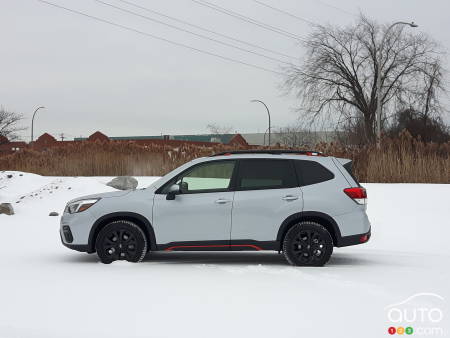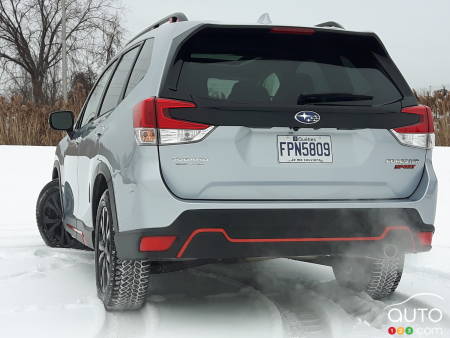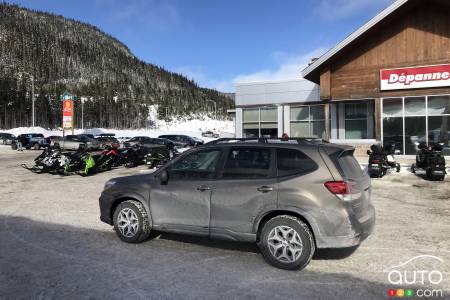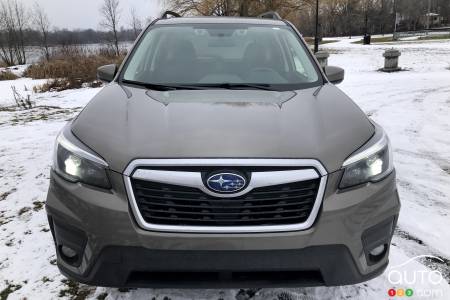Auto123 puts to the (long-term) test the 2021 Subaru Forester. Today, part 5.
See also: 2021 Subaru Forester Long-Term Review, Part 1: The Origin Story
See also: 2021 Subaru Forester Long-Term Review, Part 2: Of Buttons and Murmurs
See also: 2021 Subaru Forester Long-Term Review, Part 3: Cramming It All In
See also: 2021 Subaru Forester Long-Term Review, Part 4: The Road Trip Test
See also: 2021 Subaru Forester Long-Term Review, Part 6: Tech That Wants Your Happiness
See also: 2021 Subaru Forester Long-Term Review, Part 7: Conclusion
Surveys have shown that Subaru buyers are the ones who value all-wheel drive the most. Even more so than owners of Audi, another brand that knows a thing or two about AWD.
For these folks, having four-wheel drive on their car is just as important as its looks or its cargo capacity.
A blood pact
Over the years, what you might call a tight bargain has been struck between Subaru and its loyal fans. And that didn’t happen by chance. As early as 1990, Subaru Canada made the deliberate decision to sell only AWD-equipped cars in Canada. This is still the case today, with the exception of the BRZ coupe.
You might say the strategy has paid off, as Subaru's market share has grown heartily, and continues to grow. That share stood at 5.19 percent in Quebec in the pandemic 2020 year, versus 4.16 percent just a year prior. Generally in Canada, Subaru took up 3.39 percent of the market in 2020 (vs 3 percent in 2019), which sandwiches the automaker between Volkswagen (3.2 percent) and Mazda (3.8 percent).
Subaru believes so strongly in AWD as a basic right that its system is symmetrical and permanent. Symmetrical because if you were to slice the car in half lengthwise (not recommended), you'd see that the mechanical elements of each half are of equal length. Subaru’s engineers are so committed to the all-wheel drive system that, in the case of the Forester, they have tilted the engine slightly so that the drive shaft can travel between the two axles without running into any obstacles.
The system is called permanent because, well, Subaru's all-wheel-drive system is always on the case. You don't have to activate it, it's just there.
Another wise choice by Subaru..

Part-time vs full-time
Many manufacturers prefer to offer "responsive" AWD. On dry pavement, under normal circumstances, all the torque only serves one axle (often the front). But when the sensors detect a loss of traction, they send a certain percentage of the torque to the other axle, or even specifically to the wheels that aren't slipping.
According to those that put these systems in their vehicles, there aren't enough road situations throughout the year to warrant constant engagement of all-wheel drive.
If you live in Florida or Arkansas, that’s surely thecase. But in most of Canada, it's a different story. Subaru understands this, which is why they've adopted a permanent all-wheel-drive strategy, and why it's so popular here.
The brand's dealers have recently pushed for Subaru Canada put more emphasis on their models’ superior abilities in tough winter conditions.
For instance, how do you get to grandma’s place in a snowstorm? No worries, if you have a Subaru! How do you help a friend whose snowmobile broke down? Why, in a Subaru!

Different shades of AWD
Subaru actually deploys four types of all-wheel drive, depending on the transmission (manual or automatic) and the model. In the case of CVT-equipped vehicles, torque is roughly divided (50/50) between the axles, while the WRX and STi models benefit from settings that favour rear-wheel drive to preserve their sportiness. Then there’s active torque vectoring, which, introduced in the 2017 Impreza, refines AWD by modifying wheel rotation.
What’s important to remember is that Subaru's symmetrical and continuous AWD acts as a guardian angel to deliver torque to wheels that need it.
My girlfriend's brother, who currently drives an Outback, has been a fan of the brand for ages. He told me how his Forester of the time was able to overcome an icy course while his friend's Ford Ranger stumbled badly in comparison. His take on Subaru's all-wheel drive is colourful, and a little weird: "Their AWD is good enough to climb up a monkey's face!” Maybe Subaru could use that in one of their ads.
Specifications sheet of 2021 Subaru Forester

There is one disadvantage to equipping a vehicle with permanent all-wheel drive, however: extra pounds. Because weight, as you know, is the number-one enemy of fuel economy.
“We're stubborn at Subaru,” said Anton Pawczuk, senior public relations manager for the automaker. “Since we're so focused on AWD, we're always working to reduce the impact of weight. On the one hand, we've learned to compact the system, thus making it lighter; on the other hand, we've adopted the CVT transmission. Very often, our AWD models are as frugal as front-wheel drive rivals.”
Cherry on the sundae
As if that weren't enough, Subaru has equipped the Forester (with CVT) with X-Mode. There are even two kinds. Up until my Touring version of the model, we're talking about a single-function X-Mode, while the three models above (Sport, Limited and Premier) are graced with a dual-mode X-Mode.
In both cases, the system complements the all-wheel drive system by influencing the torque, transmission and brakes. The driver activates it with a knob on the centre console.
But isn't that a bit redundant? I already have AWD, so why add X-Mode? Am I better qualified than the on-board computer to decide what type of traction is appropriate for a given situation?
In reality, X-Mode improves on what AWD already does. It only comes into play at 40 km/h or less, so in more extreme situations, like going up or down a nasty hill. You can think of it as the low speeds provided by the transfer case of vehicles designed for off-roading or very sharp towing.
Besides, it comes standard, so why complain about it?
But I’ve gone long enough about the magic of AWD. So let's make an appointment, shall we, for a discussion next time around of another technology: the EyeSight system. Developed by optometrists? Ah, you’ll have to wait to find out...




